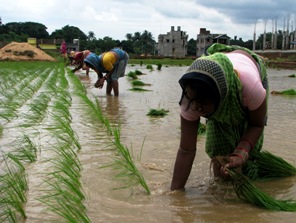By Dr Sambit Dash*
A large study of Indian agricultural markets conducted by University of Pennsylvania’s Centre for the Advanced Study of India (CASI) in association with Bill & Melinda Gates Foundation in the three Indian states of Bihar, Punjab and Odisha has brought to the fore certain key findings that should inform policymaking vis-à-vis agriculture. The study focuses on the two relatively poor states of Bihar and Odisha and uses Punjab, a wealthier agricultural state, as a benchmark. This essay shall look briefly into the aspects of market, storage and crop sale in Odisha as the CASI study findings show and the lessons therein.
Nearly 70% of Odisha population engages in agriculture. Like in most parts of India the farmer in Odisha too has tiny farms. The crop yield of the farmer in Odisha is one of the lowest in the country and so is her income. Interestingly, the Odisha Agricultural Produce Markets Act (1956) has been one of the first of its kind in India and provides much leeway in terms of sale, the players involved; yet its poor implementation has kept the farmers poor.
In the backdrop of the ongoing farmer protests, agricultural markets have come to the cynosure. In Odisha, it is not the mandi, but farmgate the areas where farmers largely sell their produce. Earlier studies have shown that proximity to mandi affects prices, and more closer a farmer is to mandi, higher the chances of his selling his produce at a higher price. But the mandi in Odisha comes active, practically, during the paddy procurement season and is not a classical active site at other times. If crop diversification and moving away from water guzzling paddy is government’s objective, perhaps the mandis needs to be analysed afresh.
A huge difference between a farmer in Punjab and Odisha is that in the latter there is virtually no auctioning. Negotiations are held at farmgate and the buyers usually quote a price which the farmer has to then decide whether to accept or not. In Odisha, there is a 17.5% improvement in prices when farmers are able to sell their crops to government agencies.
The CASI study shows that while in Punjab farmers deal with arhatiyas or commission agents, in Odisha, for example, when paddy is to be sold to Primary Agricultural Cooperative Societies, the farmer usually interacts directly with the officials of state procurement agencies. While this may sound good and desirable, and would save the farmer the money that is to be paid to the middleman, in practice, the government in Odisha buys at a lower MSP than mandated. This direct interaction also puts small farmers at a disadvantage.
The CASI study shows that farmers in Odisha receive about 2.5% higher price when they sell twice the amount of crop they usually sell. Farm-level aggregation thus seems to be a logical solution and is desirable but is scarcely practiced. The Odisha government could look into how such farm-aggregations can be facilitated while addressing the concern of lowering of quality due to mixing of different qualities of a particular crop. It is worth noting that the small farmer woes are very stark in Odisha with their produce majorly being for home consumption unlike their counterparts in Bihar.
Storage capacity, and thereby cold chains, etc, has been a topic of much debate when it comes to Indian agriculture. In Odisha, the CASI study showed that up to 88% of Odisha farmers store their crops but nearly all of them (a whopping 98%) store it in their homes. In Odisha, farmers selling to government also hold their crops for a longer time, which ideally should not be the case since the price is fixed. But this behaviour occurs because of the delayed onset of the process of buying by the government. The farmer in rural areas were seen to hold their crops for longer duration. Reasons include both remote areas being far from district headquarters, the usual mandi or farmgate, and finding buyers after a prolonged gap as those farmers who are closer to mandis/farmgate sell to the bulk of the buyers.
Fundamentally, farmers, small ones in Odisha should be selling their crop right after the harvest. For maize, for which there is no government procurement, the average holding time for farmer in Odisha is more than three months (39.9 days), a considerable time. It is to be noted that selling late does not confer any advantage in terms of pricing.
There are a few positives about agriculture in Odisha, be it the freedom the APMC Act provides, the wide variety of markets available to sell produce and in what could be an indicator of a well-functioning fair average quality (FAQ) by Odisha government, farmers were found to engage extensively in post-harvest processing of drying, cleaning, sorting and grading.
Despite these, concerns of procurement below MSP, inaccessible mandis especially for remotely located farmers, the huge predominance of “paddy” as the preferred crop (and for policies of government procurement), delayed procurement cycles and problems of storage associated with it, are just a few issues that needs to be addressed. While the clarion call for doubling farmer’s income is laudatory, in practice, doubling of farmer’s income took 22 years, from 1994 to 2016, and the new seven year target, culminating in 2023, set by the Union government is lofty for the uniqueness of problems and there solution likewise will take a much longer and focused approach.
*The writer is a senior grade lecturer in the Department of Biochemistry at Melaka Manipal Medical College, Manipal University by profession and a blogger by inclination.
DISCLAIMER: The views expressed in the article are solely those of the author and do not inany way represent the views of Sambad English


Comments are closed.